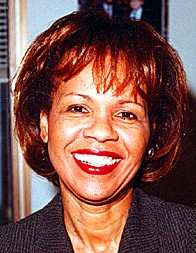Wed, Sep 29, 2004
A Look Inside The FAA Office That Regulates Commercial Manned
Spaceflight
 Since 1984, Patricia Grace Smith's
office at the FAA has been licensing commercial rocket launches.
The payloads have always been satellites or research equipment --
until Burt Rutan and Paul Allen changed things with the flight of
SpaceShipOne back in June. It was Smith's office that gave Scaled
Composites and pilot Mike Melvill the final regulatory go-ahead for
that record flight and it was Smith who pinned the first ever
commercial astronaut wings on Melvill's chest when he returned.
Somewhere in that entire process, someone had to do a lot of
paperwork.
Since 1984, Patricia Grace Smith's
office at the FAA has been licensing commercial rocket launches.
The payloads have always been satellites or research equipment --
until Burt Rutan and Paul Allen changed things with the flight of
SpaceShipOne back in June. It was Smith's office that gave Scaled
Composites and pilot Mike Melvill the final regulatory go-ahead for
that record flight and it was Smith who pinned the first ever
commercial astronaut wings on Melvill's chest when he returned.
Somewhere in that entire process, someone had to do a lot of
paperwork.
"It takes a great deal of work," Nicholas A. Sabatini, associate
administrator for regulation and certification, told the Washington
Post. His duties include oversight on experimental aircraft (you
might remember him from the FAA forum at Oshkosh earlier this
year). "You have cultures within the organization, so you have to
think outside the box."
That sort of thinking -- especially in a bureaucracy -- is
revolutionary. While a lot of companies trying to get into space
have groused about a process that moves at the speed of sludge,
many have gone out of their way to praise Smith for her sensitivity
and can-do attitude.
"If this industry is over-regulated, it could be killed in its
infancy, and Patti is well aware of that.... Don't regulate a moped
the way you regulate a Mack truck," said X-Prize founder and
president, Peter Diamandis, in an interview with the Post. He
pointed out that the designs offered by X-Prize competitors are far
less powerful than space vehicles carrying commercial payloads for
paying customers.

What does Smith herself say about all this? "I truly, truly see
space as transportation... not unlike aviation, not unlike rail,
not unlike transit -- an intermodal, interconnected system that
creates benefits for the nation," she told the Post.
Are we really sure she works for the government?
More News
Pilot Also Reported That Due To A Fuel Leak, The Auxiliary Fuel Tanks Were Not Used On June 4, 2025, at 13:41 eastern daylight time, a Piper PA-23, N2109P, was substantially damage>[...]
Have A Story That NEEDS To Be Featured On Aero-News? Here’s How To Submit A Story To Our Team Some of the greatest new stories ANN has ever covered have been submitted by our>[...]
From 2023 (YouTube Edition): Reflections on War’s Collective Lessons and Cyclical Nature The exigencies of war ought be colorblind. Inane social-constructs the likes of racis>[...]
Aero Linx: Colorado Pilots Association (CPA) Colorado Pilots Association was incorporated as a Colorado Nonprofit Corporation in 1972. It is a statewide organization with over 700 >[...]
High Speed Taxiway A long radius taxiway designed and provided with lighting or marking to define the path of aircraft, traveling at high speed (up to 60 knots), from the runway ce>[...]
 NTSB Prelim: Piper PA-23
NTSB Prelim: Piper PA-23 ANN FAQ: Submit a News Story!
ANN FAQ: Submit a News Story! Classic Aero-TV: One Mans Vietnam
Classic Aero-TV: One Mans Vietnam ANN's Daily Aero-Linx (07.03.25)
ANN's Daily Aero-Linx (07.03.25) ANN's Daily Aero-Term (07.03.25): High Speed Taxiway
ANN's Daily Aero-Term (07.03.25): High Speed Taxiway




